How to Draw a Squirrel
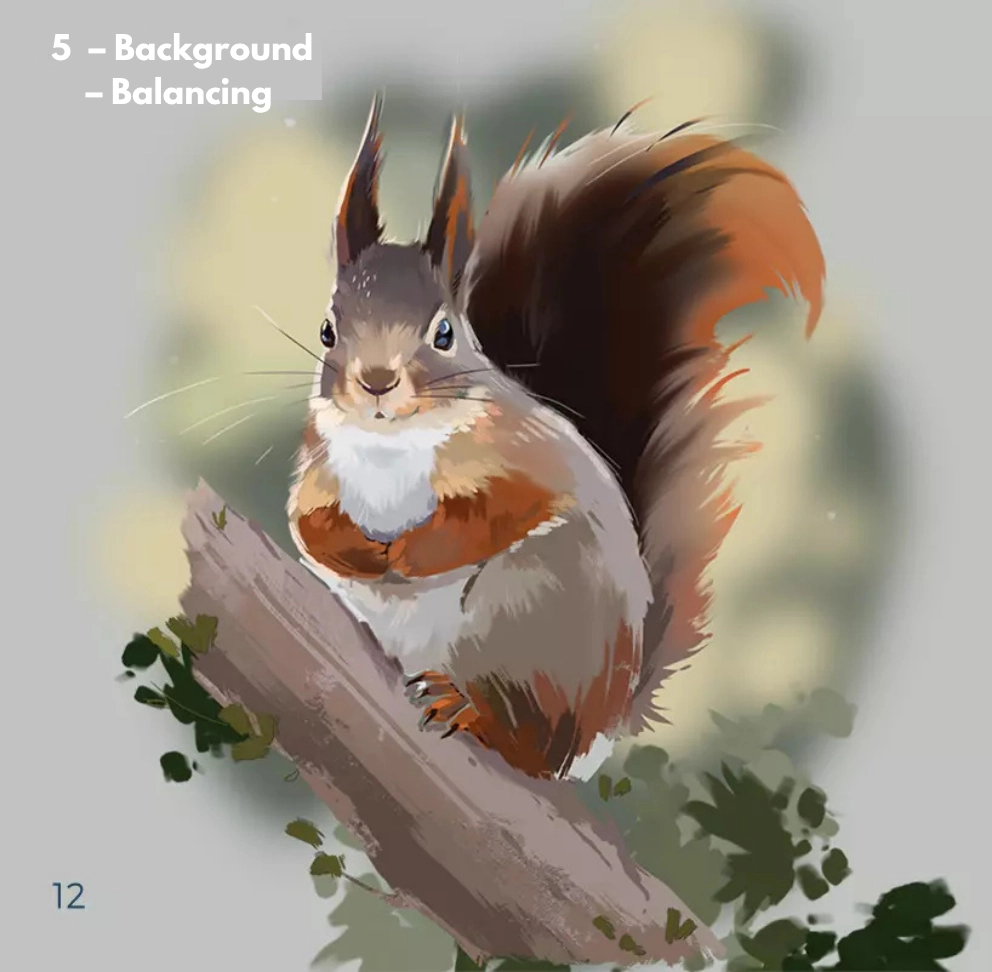
There is a multitude of squirrels, but let's focus particularly on the one native to our country: the red squirrel, this adorable mammal from the Sciuridae family.
THE RED SQUIRREL, A TRUE LOCAL ANIMAL
Despite its small size not exceeding 50 cm in total, this rodent has undeniable flair with its bushy tail! On its rounded head ending in a pointed snout, its eyes form two small dark beads.
A little-known detail: the hair in its ears is short in summer and grows at the end of the season to become long, referred to as "tufted," during the fall and winter.
His body, for its part, is rather long, which is not noticeable when he is sitting.
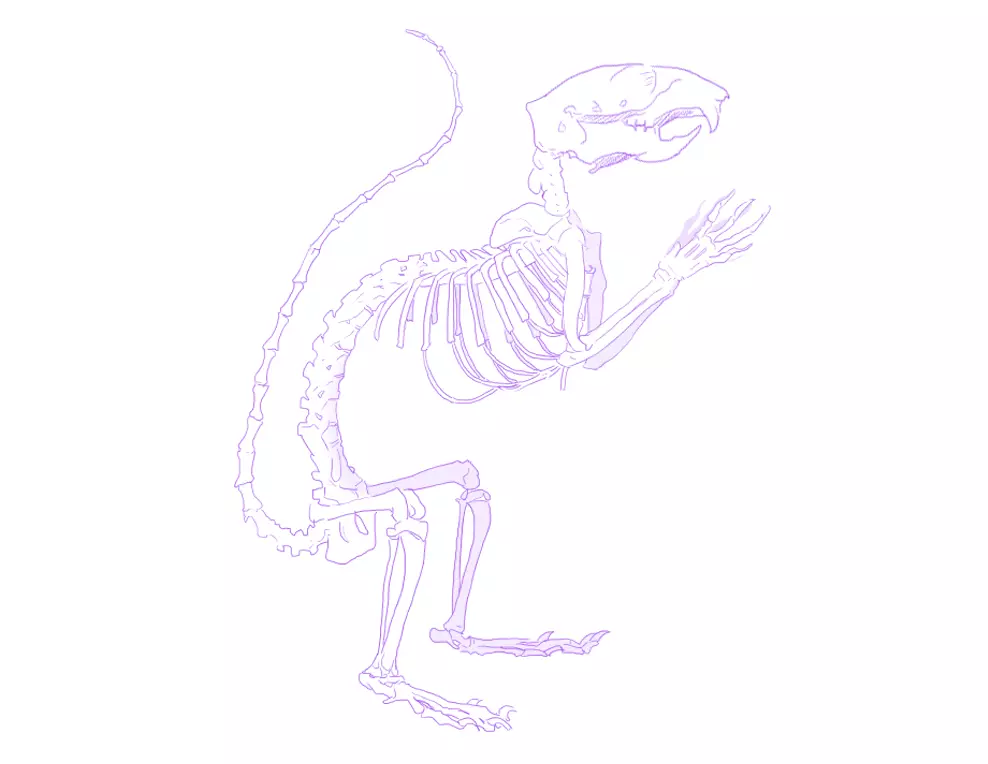
Its hind legs are very well-developed and it has long feet. Its arms are smaller, and placed close to its chest. Its tail helps it maintain balance when moving, as it is both a climber and a sprinter who also does not hesitate to leap through the air, from tree to tree. A true athlete.
DRAWING SQUIRREL SKETCHES
We can start by making quick sketches of it from various angles. We then understand its morphology and how it interacts with its environment.
For applied sketches, we focus on the movement of its fur. At this stage, let's keep the lines light and simple, without shading while keeping in mind its skeleton:
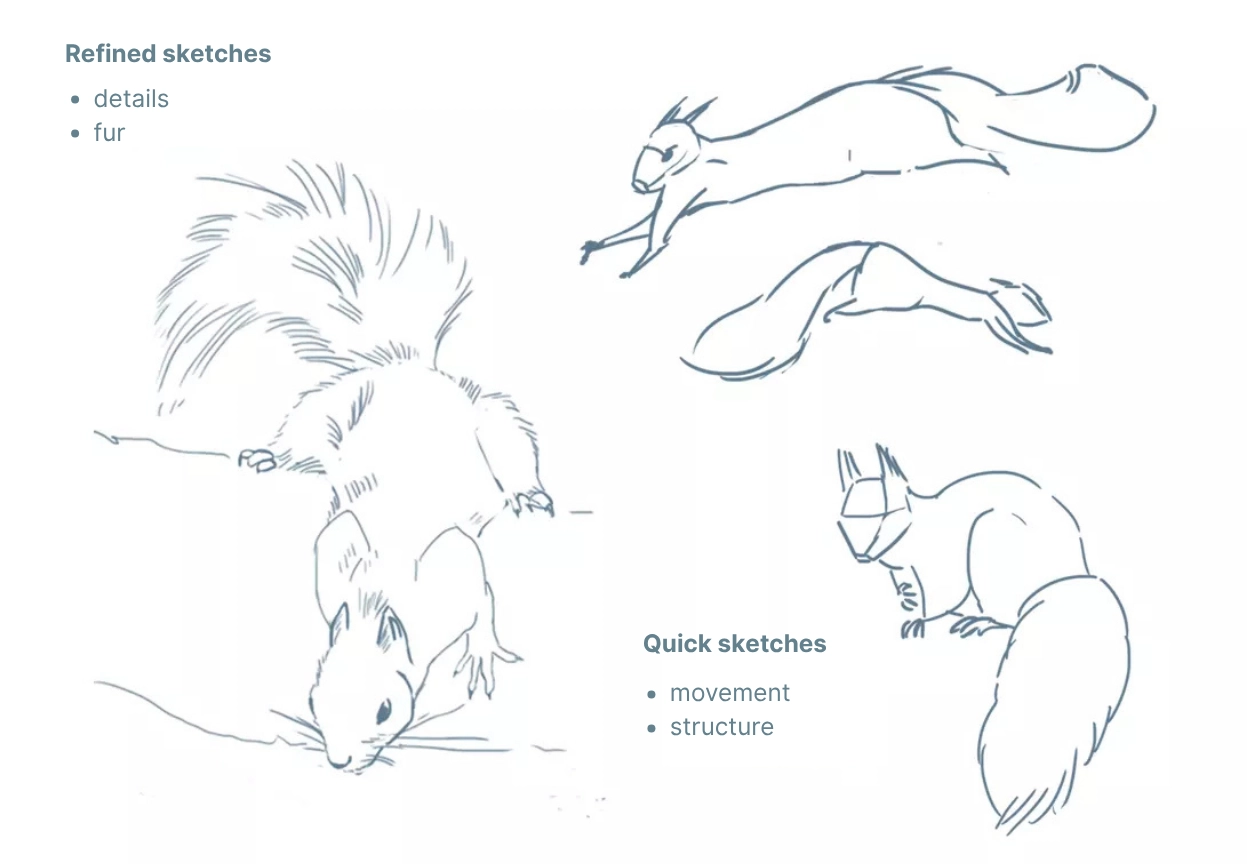
• When it runs, its body and tail stretch out horizontally: this should be expressed by flattening the curvature of the back.
• Sitting, his back has an extremely pronounced curvature, almost 90°.
JOINTS AND SHAPES
Let's take a look at its features:
• its head is 1/3 of the total height of its body (excluding the tail),
• his eyes are located halfway down his face,
• he is all curves.
His posture varies drastically depending on his activity:
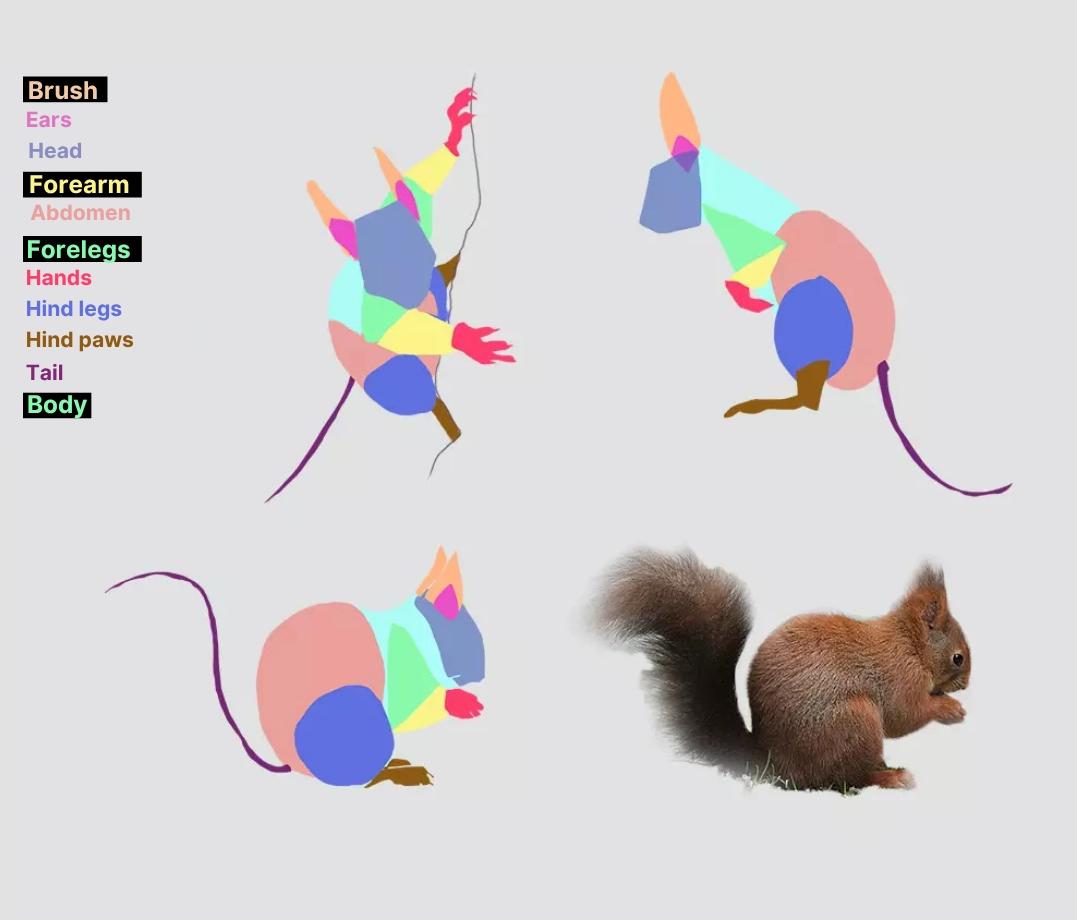
We can choose to focus only on the graphic elements that reveal the essence of the animal. If it is represented from a distance or running, it is its silhouette that will give your drawing its full scope.
In short, it's about putting technique at the service of the subject matter. We can understand the character even with a simplified rendering rather than a highly technical drawing:
THE DIFFERENT COLORS OF THE SQUIRREL
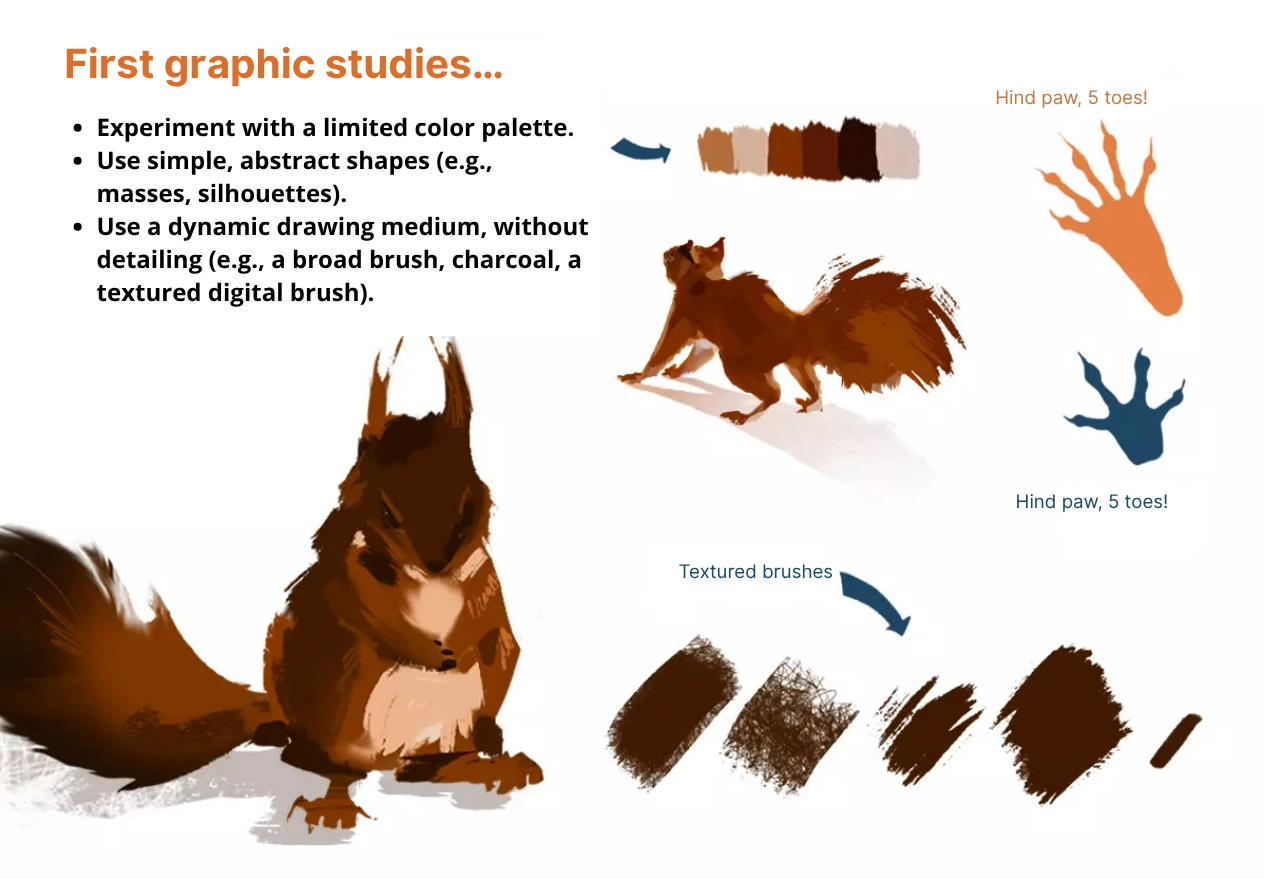
The red squirrel takes on soft autumnal shades, sometimes turning gray-black. The underside of its belly and paws is white.
Let's represent it with these shades of color:
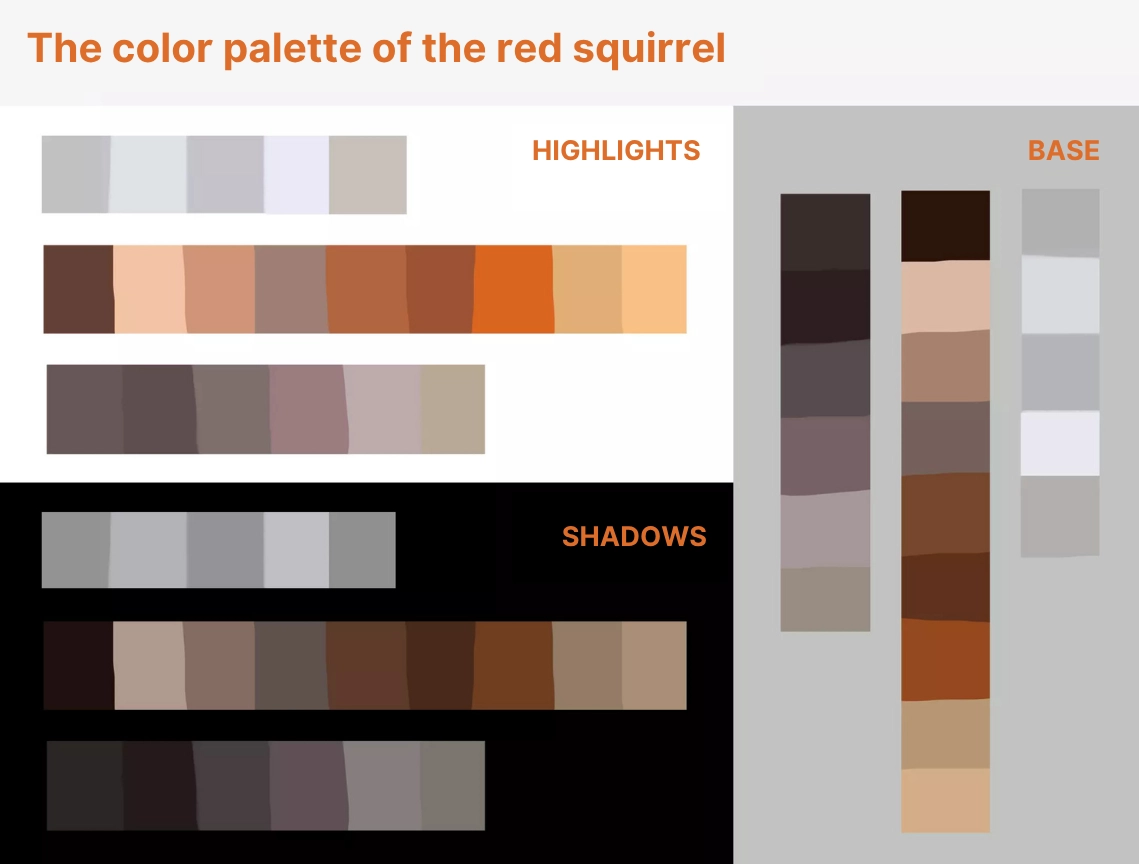
Tips!
• Black and white are colors to avoid to maintain a dynamic rendering, unless you are performing a monochrome. For shadows, we can tint our colors with purple or blue, and add yellow (a warm color) to our browns and grays for the lights. In the palettes above, there is neither white nor black (in contrast with the backgrounds of the palettes).
• Let's keep a deep russet to be used sparingly to signify bursts of light.
DRAW A SQUIRREL STEP BY STEP
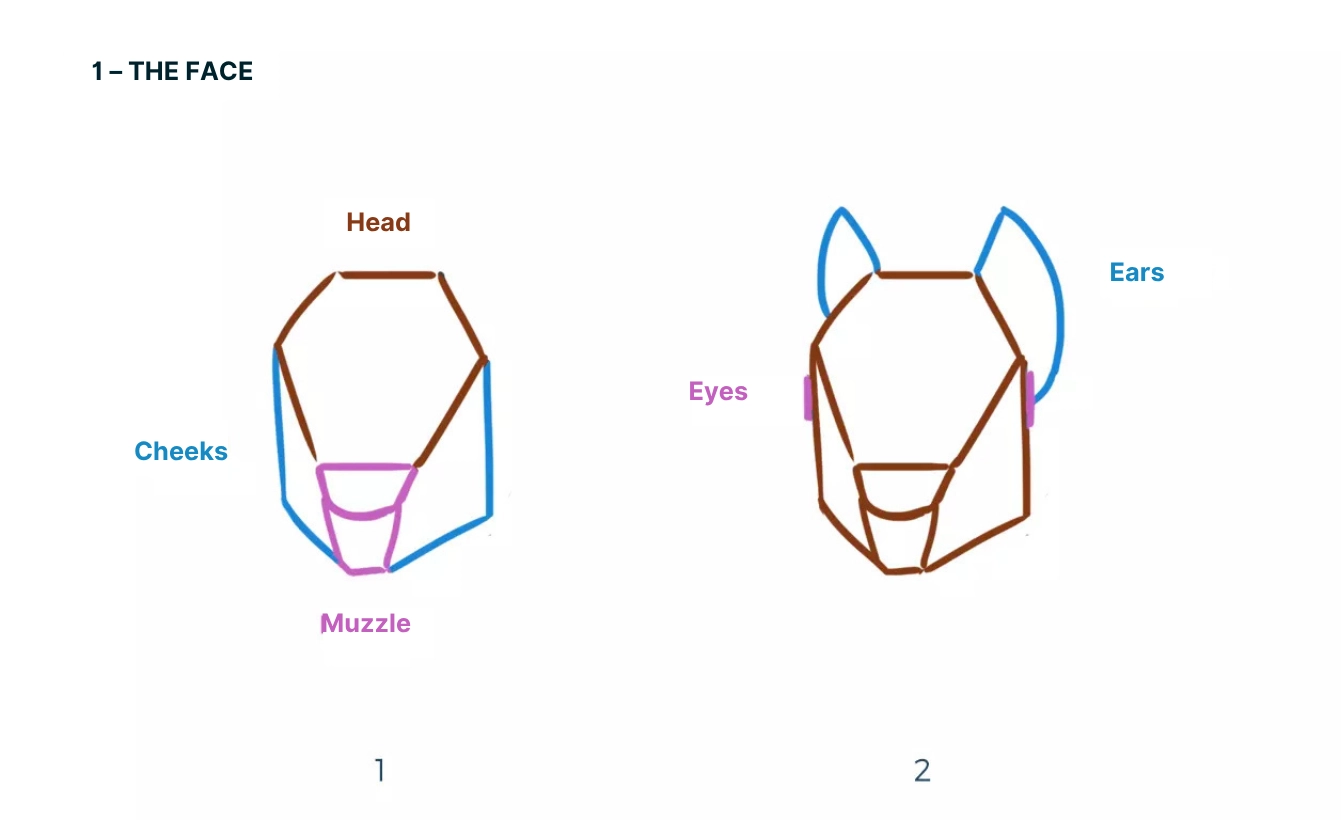
A/ For his pointed face, the top of his head will have a diamond shape that fits within a rectangle slightly taller than it is wide.
B/ I draw two parallel lines for the cheeks, the same size as the height of the diamond.
Let's not forget the muzzle, that purple half-circle. I continue the line down to the bottom of the face.
I'm adding the round ears: one ear is more visible than the other from a 3/4 angle. For now, I'm representing the eyes with two lines.
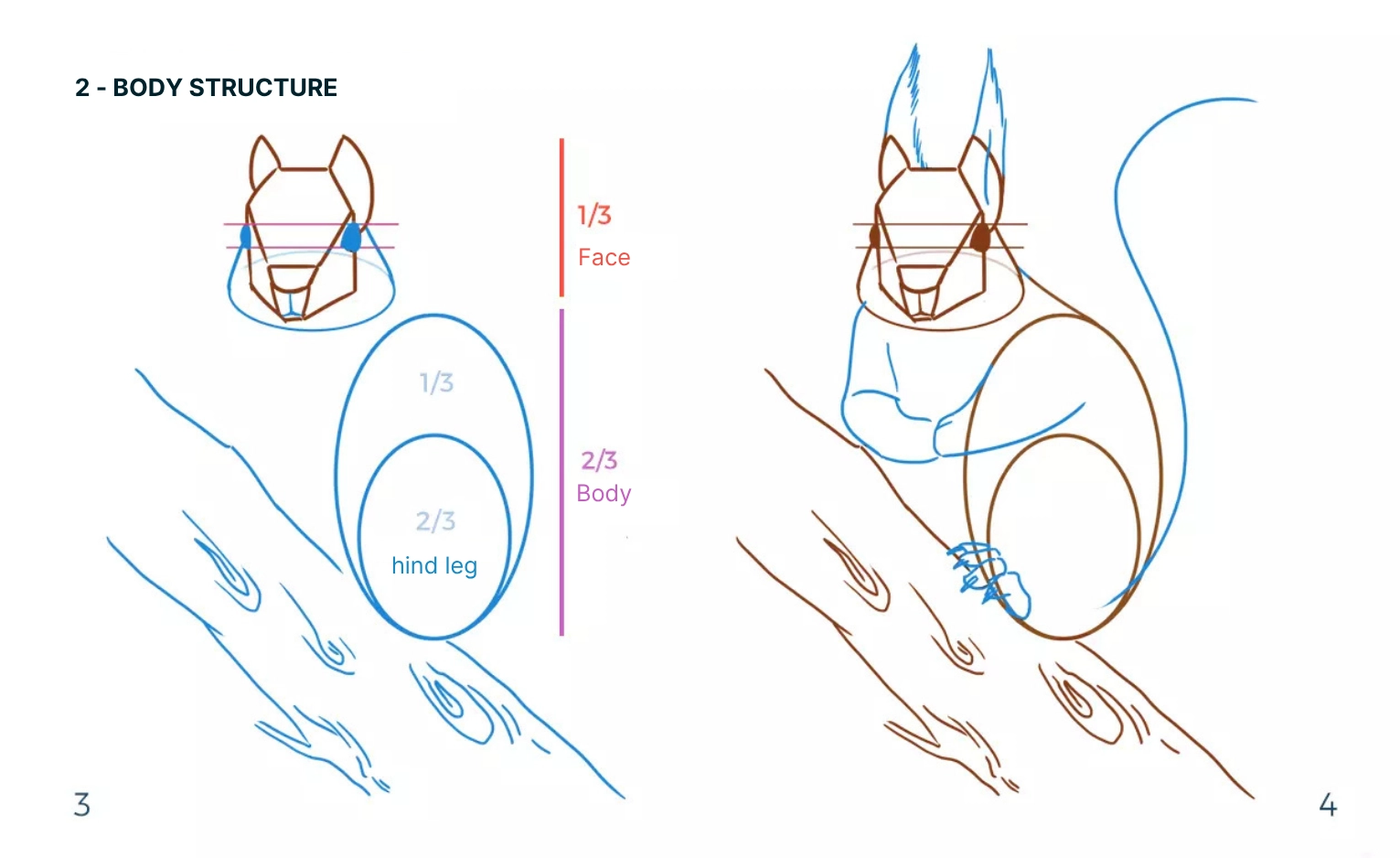
A/ I take the height of the face, and transfer it twice from the bottom of the snout to get the height of the body. We will draw a first oval slightly to the right of the face making thus 2/3 of the total height. Then, another oval is drawn inside it at two-thirds the height of the big oval for the back leg.
B/ Place the eyes where the lines were. The one on the left is a thin oval, the one on the right is wider, with a point to represent the lacrimal caruncle.
I'm adding a tree branch to set the scene. There, that's better!
I represent the funnel-shaped cheeks around the cheeks. Let's also draw two curves for his mouth.
E/ I add the brush-like fur on its ears and its short arms. It brings its paws together, so there is no need to detail the fingers which are tucked inward.
F/ I'm starting the skeleton of its tail.
G/ I draw the toes visible at the base of the body. It has 5 toes per paw but in this position, we can only see 4.
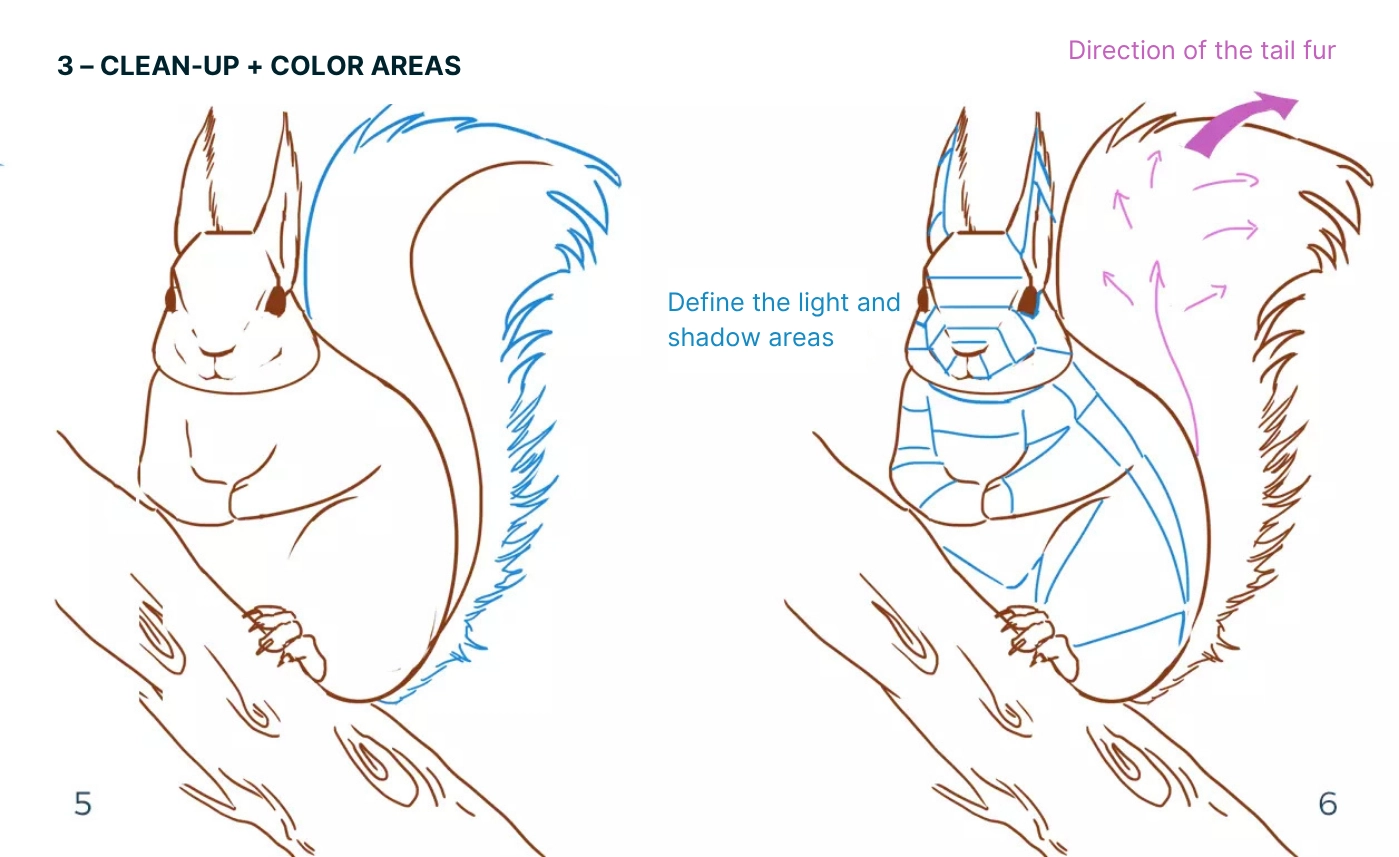
A/ Let's remove the unnecessary construction lines.
We define the color zones. These zones will be divided into "lights" and "shadows," taking into account the natural colors of the squirrel (the base colors) as well as the shapes of its body because it needs to be broken down like a 3D object, with volume. The colors will remain matte due to the low level of fur reflection: it is not a smooth and wide surface like glass or metal.
Let's take the example of a red squirrel with fur that is turning grey to have a wider range of colors. We keep as a reference the palette found earlier by observing the animal.
ADD COLOR TO THE SQUIRREL DRAWING
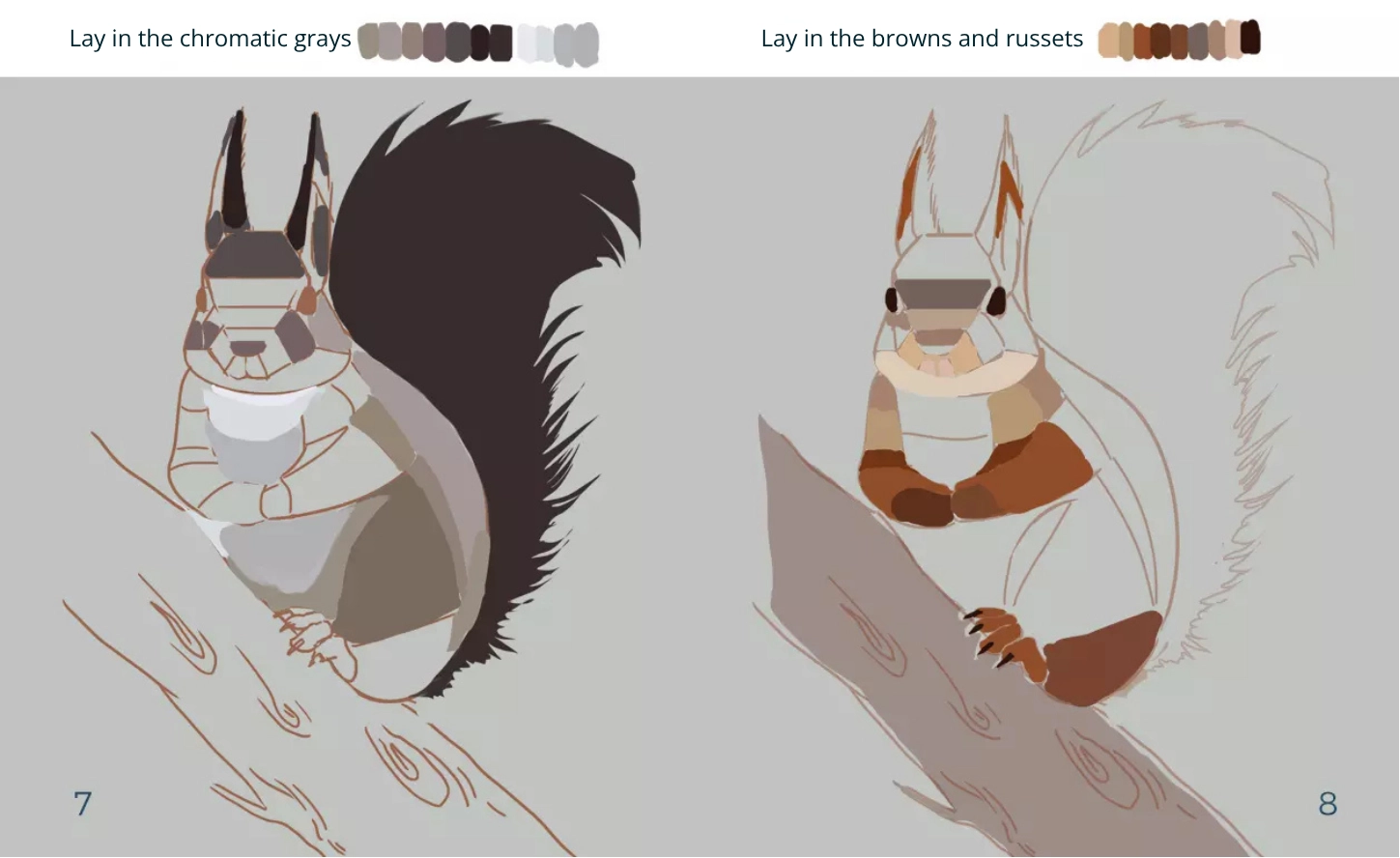
A/ I choose a shaded gray background color to place the squirrel in an environment. This will also give more impact to the future lights.
B/ Let's place simple flat areas with the basic colors of the palette. I have divided the gray and brown tones for more clarity.
There is a gradient from gray to beige on its face. The belly is the lightest element; we will fade around it with beige for the underside of its face, light brown for its shoulders, russet for its paws, and shades of gray tinged with brown for its body.
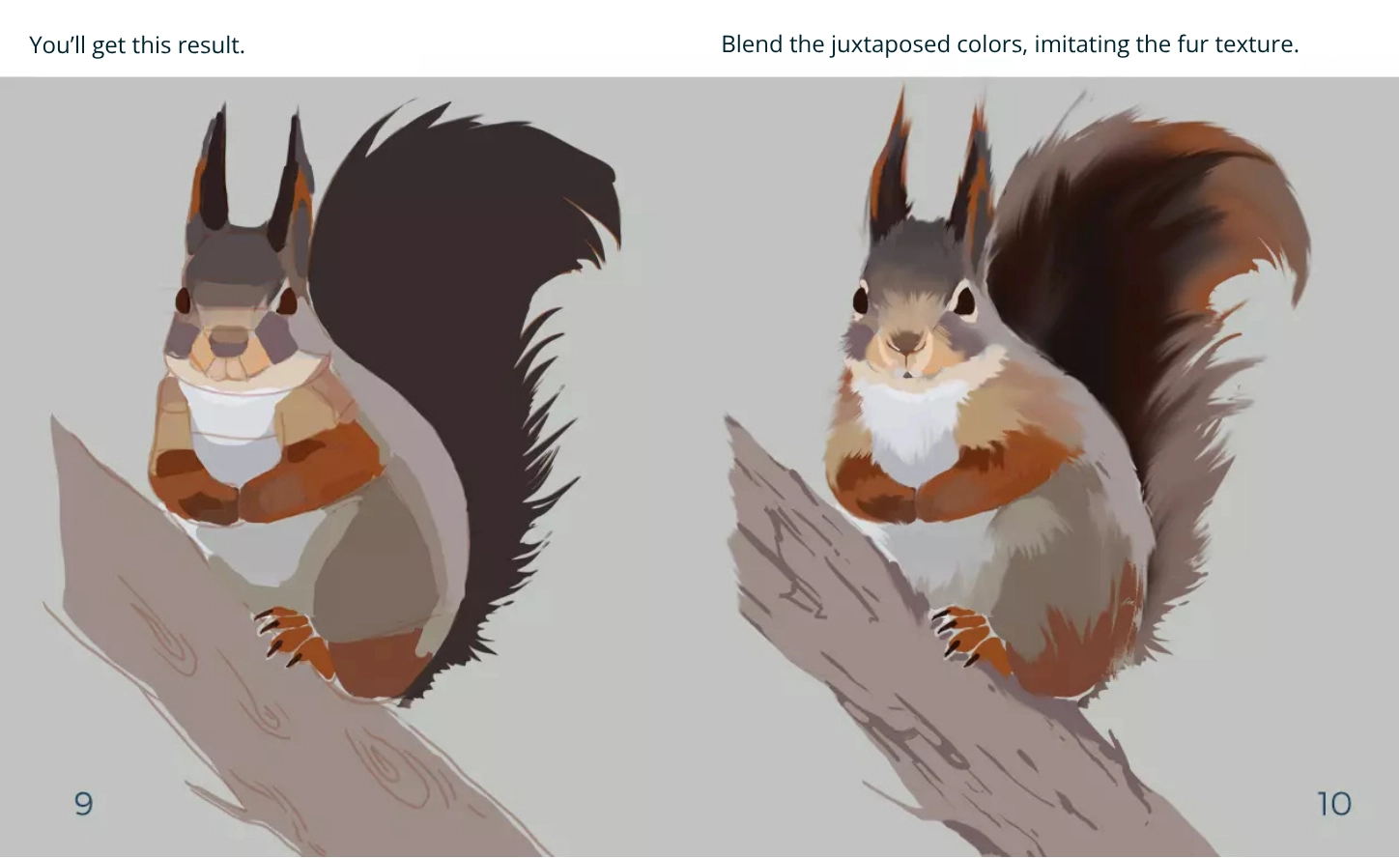
A/ I imitate the direction and texture of the fur by mixing the tones.
B/ For its fur, there are three types of lengths; short on the face and legs, which transitions to medium-length hair on its back and belly. Its tail, however, boasts long, plume-like hairs.
Hence, we can draw the hairs of its tail by letting the brightness of the surrounding decor show through, while the rest of the body should be colored in an opaque manner to signify this difference in density.
To color the eye, a very dark red gives a natural look. Its eye is surrounded by a border of light hairs.
ADD DETAILS TO YOUR SQUIRREL DRAWING
We are getting to the funniest part where one can add their personal touch to the drawing!
We can detail the fur with small brush strokes. I layer increasingly lighter shades to give texture to the coat. In fact, we're not going to treat it the same way everywhere in order to avoid a flat rendering: small strokes in places are enough to suggest the fur, in contrast with broader strokes, like on its hind leg.
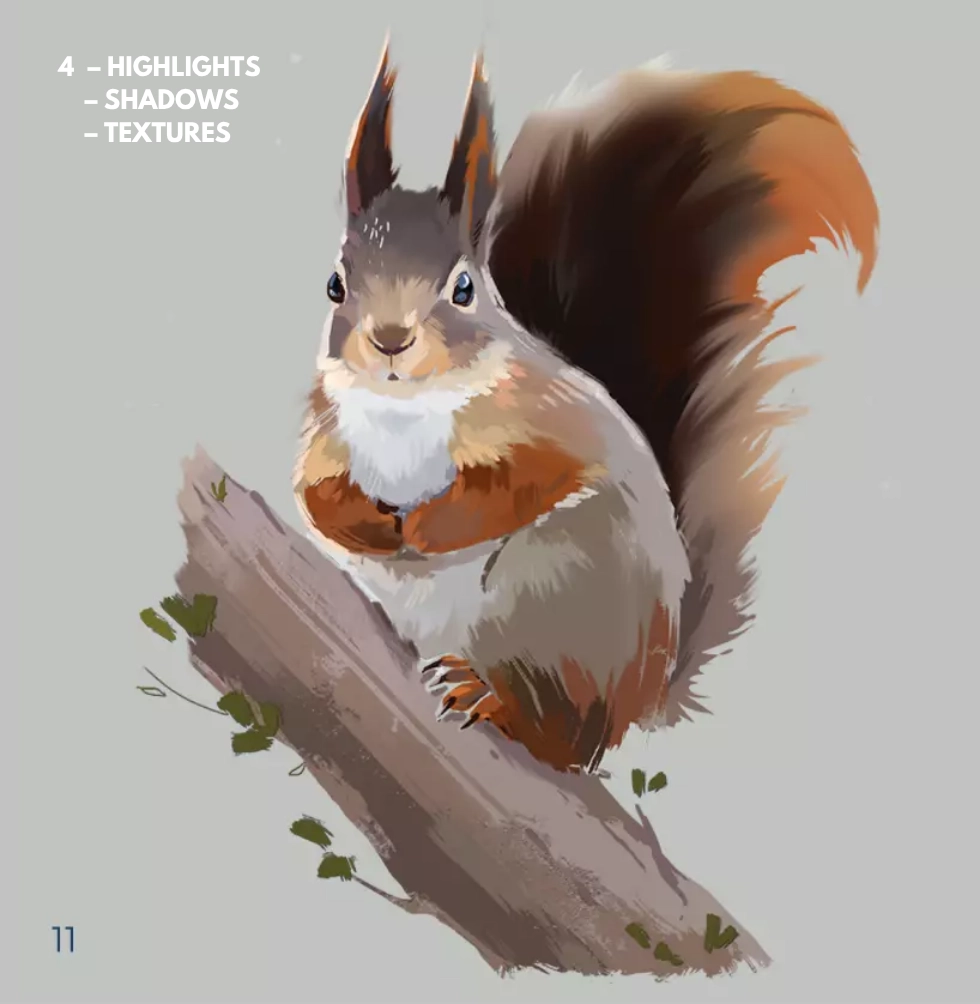
A/ Adding shadows:
I take a base shade and reduce its brightness and saturation. I choose the deepest brown for its tail to contrast with the light gray of its body. I shade the belly with a bluish light gray around its front paws. I darken the lower body and the wood of the tree. I create a shadow on the branch, at the base of the squirrel's body.
B/ Adding lights:
Let's take a base shade of the drawing and add some brightness and saturation. For very sharp lights, we can directly apply a pale golden yellow. That’s what I did for the left contours of the squirrel that are directly facing the light.
It must be remembered that light revolves around an object: there are bursts of light on the straight edges of the squirrel’s body, even if they are less intense. I add a clear light on the tip of the squirrel's tail to indicate that the fur there is less dense and that the light passes through, adding its characteristic red hue.
C/In her eyes, I add bluish reflections, and a very light blue sparkle.
Hello! How can I help you today?I start a foliage on the trunk with small branches and leaves.
At this stage, we can take a break and step back to reflect on our work...
Let's correct any errors in proportion or color, and add some detail!
I mention a small claw on its front paw, sketch some very sharp hairs on its tail to contrast with the dynamic blur of the rest of the drawing without overdoing it.
Finally, when each element is nicely finished, I draw a few whiskers, suggesting them without drawing them all.
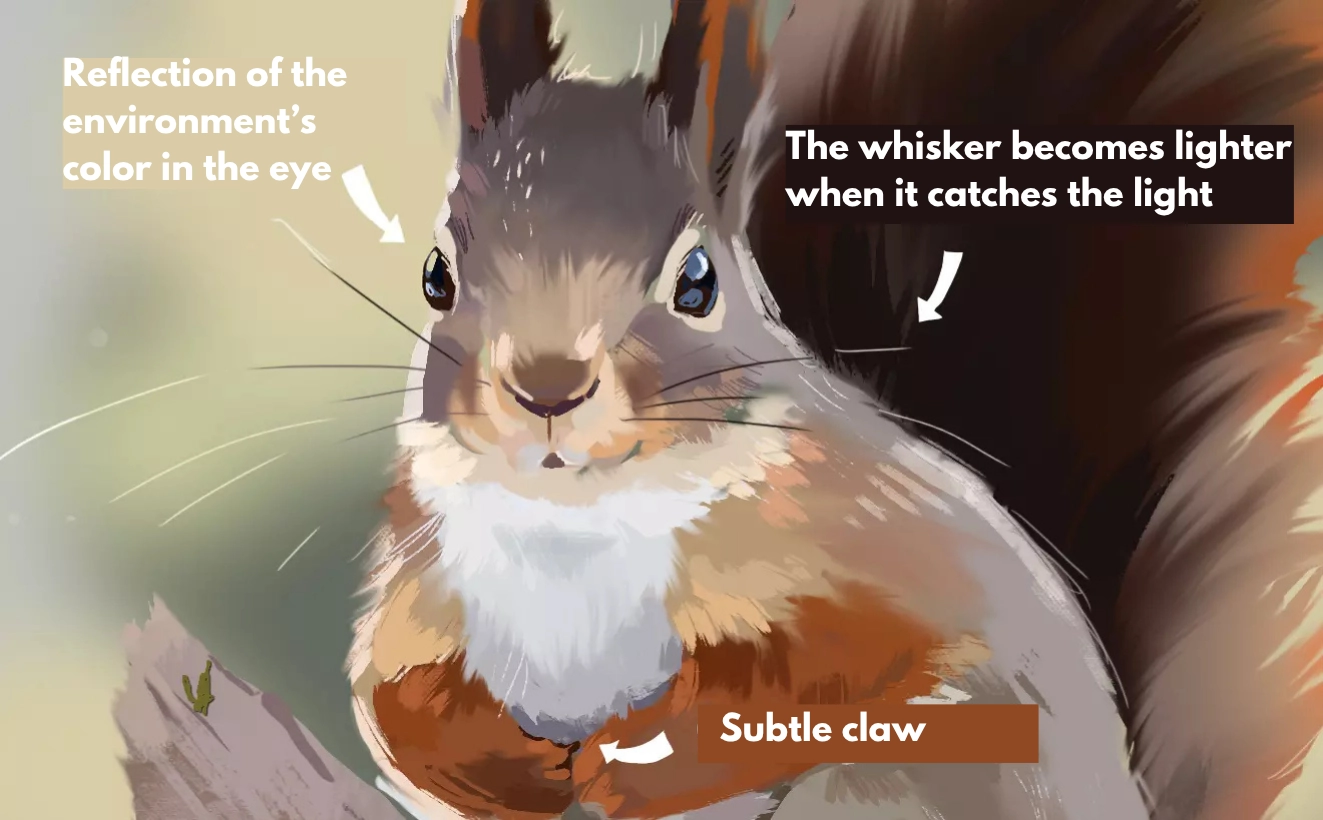
A/ I'm adding a simple, blurred background that evokes nature and bathes it in light.
B/ On the branch: sparse foliage, bordering on abstract so as not to steal the spotlight from our squirrel.

And it's done!
Illustrator and Writer:Vincyane


It's magnificent, thank you Liam